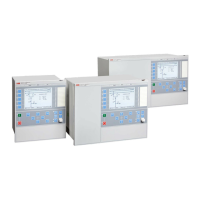If the parameter
RemoteIncStation
is set to
Yes
, commands from IEC 61850-8-1 clients at both
station and remote level are accepted, when the QCBAY function is in Remote. If set to
No
, the
command LocSta controls which operator place is accepted when QCBAY is in Remote. If
LocSta is true, only commands from station level are accepted, otherwise only commands
from remote level are accepted.
The parameter
RemoteIncStation
has only effect on the IEC 61850-8-1
communication. Further, when using IEC 61850 edition 1 communication, the
parameter should be set to
Yes
, since the command LocSta is not defined in
IEC 61850-8-1 edition 1.
12.3.8.2 Switch controller (SCSWI)
M16673-3 v6
The parameter
CtlModel
specifies the type of control model according to IEC 61850. The
default for control of circuit breakers, disconnectors and earthing switches the control model
is set to
SBO Enh
(Select-Before-Operate) with enhanced security.
When the operation shall be performed in one step, and no monitoring of the result of the
command is desired, the model direct control with normal security is used.
At control with enhanced security there is an additional supervision of the status value by the
control object, which means that each command sequence must be terminated by a
termination command.
The parameter
PosDependent
gives permission to operate depending on the position
indication, that is, at
Always permitted
it is always permitted to operate independent of the
value of the position. At
Not perm at 00/11
it is not permitted to operate if the position is in
bad or intermediate state.
tSelect
is the maximum allowed time between the select and the execute command signal,
that is, the time the operator has to perform the command execution after the selection of the
object to operate. When the time has expired, the selected output signal is set to false and a
cause-code is given.
The time parameter
tResResponse
is the allowed time from reservation request to the
feedback reservation granted from all bays involved in the reservation function. When the time
has expired, the control function is reset, and a cause-code is given.
tSynchrocheck
is the allowed time for the synchrocheck function to fulfill the close conditions.
When the time has expired, the function tries to start the synchronizing function. If
tSynchrocheck
is set to
0
, no synchrocheck is done, before starting the synchronizing function.
The timer
tSynchronizing
supervises that the signal synchronizing in progress is obtained in
SCSWI after start of the synchronizing function. The start signal for the synchronizing is set if
the synchrocheck conditions are not fulfilled. When the time has expired, the control function
is reset, and a cause-code is given. If no synchronizing function is included, the time is set to
0
,
which means no start of the synchronizing function is done, and when
tSynchrocheck
has
expired, the control function is reset and a cause-code is given.
tExecutionFB
is the maximum time between the execute command signal and the command
termination. When the time has expired, the control function is reset and a cause-code is
given.
tPoleDiscord
is the allowed time to have discrepancy between the poles at control of three
one-phase breakers. At discrepancy an output signal is activated to be used for trip or alarm,
and during a command, the control function is reset, and a cause-code is given.
1MRK 505 370-UEN D Section 12
Control
Busbar protection REB670 297
Application manual

